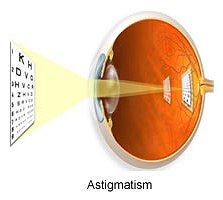Astigmatism
 ASTIGMATISM is a common condition of the eye that causes blurred or distorted vision. Affecting perhaps as many as one third of people, it occurs when the cornea or lens is not a perfectly curved shape and is slightly more like a rugby ball than a football in outline. In most cases an astigmatism is present at birth, but can develop after an injury to the eye, as a result of eye surgery or with age. Most people who wear glasses have some degree of astigmatism.
ASTIGMATISM is a common condition of the eye that causes blurred or distorted vision. Affecting perhaps as many as one third of people, it occurs when the cornea or lens is not a perfectly curved shape and is slightly more like a rugby ball than a football in outline. In most cases an astigmatism is present at birth, but can develop after an injury to the eye, as a result of eye surgery or with age. Most people who wear glasses have some degree of astigmatism.
What are the symptoms of Astigmatism?
Light rays entering the cornea – the transparent layer of tissue at the front of the eye – may not be focused correctly, creating a blurred image. Astigmatism is usually diagnosed after a routine eye test, and this is a condition which can be treated surgically. If left untreated an astigmatism may cause headaches and eyestrain, particularly when working at the computer or other close work.
What are the treatments?
Correction of astigmatism is particularly relevant during cataract surgery and any refractive procedure aimed to remove spectacles. Techniques include astigmatic corneal incisions, toric lens implants and laser. In Mr Saeed's cataract practice, particular attention is paid to eliminate or reduce astigmatism where possible.




